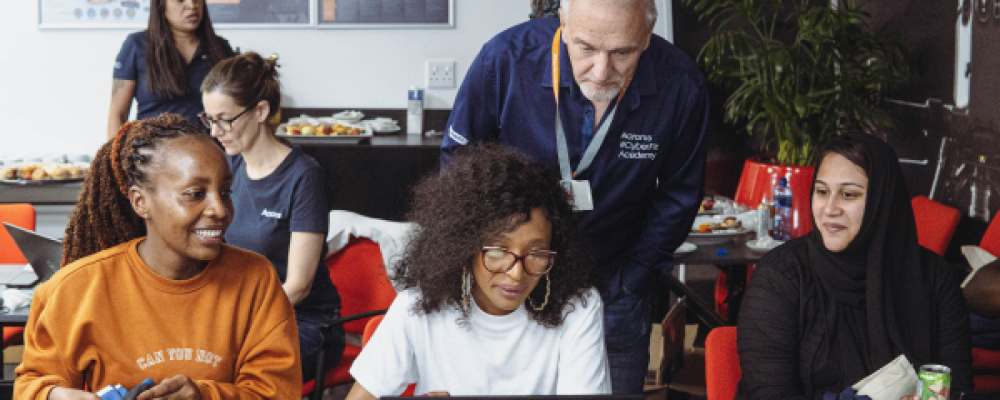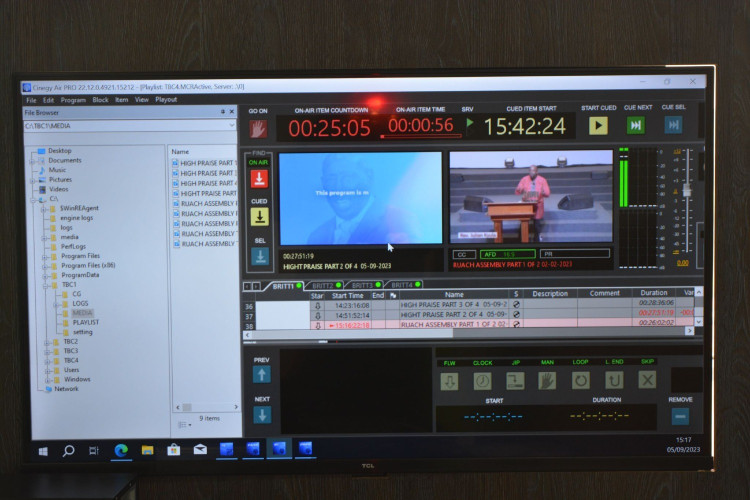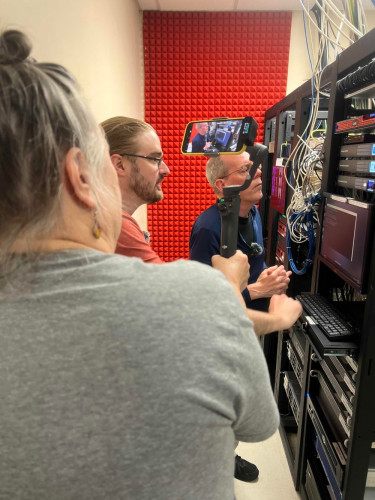Test and measurement in digital television

Author: Bob Pank#
Published 1st July 2011
Do we need to worry about test and measurement in digital television?
Let’s be clear about this. Test and measurement tools are not there to make life difficult for you, they are there to ensure that we get the best quality pictures and sound through the long path to the home within a required technical specification. So yes, simply put, checking that we are getting the best out of the technology – that black is black, white is white, and colours can be reproduced accurately within the tolerances broadcasters set– is vital.
It is true that digital systems are stable, so a signal can be passed from one device to another without degradation. But we need to consider the two primary areas, the first where changes through equipment can change the signal, the other where creative personnel can changes the signal parameters. So whenever a device has the capability of changing the quality of the signal we need to make sure that it is still operating within specification.
Once the electronic to electronic (E to E) path is established as being OK, it is the operational areas that we need to look at. Hamlet encourages production staff to think from first principles – to get it right in the can from the offset. We need to get the best out of the camera, obviously, obtaining the best contrast ratios making sure the black and whites have no colour bias. Indeed using the waveform monitor on a HD shoot can assist with focus! Every edit system today has colour correction facilities, which can put you out of gamut. Overlaying graphics onto a picture can do the same and possibly insert unsuitably sharp edges which under scrutiny will be rejected.
Good test equipment should be simple to use, and will make it obvious to you when something is wrong, guiding you to put it right before you sign off on it.
What happens if I just ignore the problem?
If you deliver a programme which has out of specification content, one of two things will happen.
First, the quality control pass of the broadcaster will reject the programme and send it back to you to put right. That means more work, more cost and a reputation for not caring about quality.
Alternatively, if it’s expedient to do so, the broadcaster will just push the content through a legaliser, which will electronically adjust the content to make it fit within the broadcaster’s specifications. Neither you nor more importantly the director, will have any control over what happens in this process, and nor will anyone else. In a commercial costing many hundreds of thousands of pounds, will the clients pack shot be the right colour! Colours may be all over the place, and there is a good chance that vital details in the picture will be lost. The director and client seeing it on screen will note that you do not care about their product or quality.
All right. I understand I have to do this. What key parameters should I check?
Bearing in mind both video and audio are actually originally analogue, we have to make the best interpretation into a digital domain, to reproduce these signals as close to reality as is technically feasible.
In vision, it is possible to check the synchronisation, video levels, tolerances, distortion, timing, active area period, end and start of active video, EYE pattern display and existence of audio embedded in the video - to name a few. You use a waveform monitor to check these.
You also need to check colour gamut. It may be hard to grasp, but there are some colours that cannot, when added together, be reproduced on television, because of the way we convert each colour to the three primaries: red, green and blue. If you push your colour correction system you can get outside that legal gamut of colours, which can be catastrophic.
With the aid of vectorscopes and other displays, gamut characteristics can be assessed with ease.
For sound, you need to know that levels are consistent through the programme, and are not so loud as to cause distortion, that the audio is where it is supposed to be in the embedded, AES/EBU or analogue domain.. In some countries it is common practice to utilise a high gain at the bottom of audio scales to assess the quietness of the audio achieved, is there unwanted noise there? In stereo you need to check the phase of the output, something which is even more important for surround sound. Substantial out of phase audio makes audiences feel uncomfortable at best and nauseous at worst.
It sounds like I need a huge number of screens
Traditionally each of these instruments would be a separate device; Hamlet was first to integrate both waveform and vectorscope into an instrument, adding audio later, then signal generation. Depending on the area of operation in some places in a broadcast facility they are still separately displayed on an instrument that can show many trace displays.
But for operational areas there are modern tools like the award winning Hamlet DigiScope DS900 and VidScope range, which puts up to multiple measurement and monitoring displays on a single computer monitor. VidScope is a particularly cost-effective buy, easy to use and understand, and as accurate as a traditional instrumentation.
On my checklist is something called PSE. What is this and what can I do about it?
About one in 5000 of the population suffers from something called photosensitive epilepsy, or PSE. Flashing lights, or certain colour combinations, can set off an epileptic episode which is devastating for the sufferer and those who have to offer care.
Recently doctors and engineers have collaborated to determine the precise causes of a PSE episode. From this we have been able to develop algorithms to measure for this and to trap potentially dangerous sequences before the programme is transmitted. So when you are looking for new test and measurement tools, make sure you check that PSE, to the agreed international standard (ITU recommendation 1702) is included.
And if you think that one in 5000 sounds like long odds, remember that a moderately successful programme might have an audience of five million, which means a thousand people could be made to suffer because of it.
Do I need to worry about audio?
You certainly need to keep an eye on all levels, amplitude, frequency response, channel separation, noise, balance between stereo or surround channels, and phase. Some of these are performed in the engineering domain.
There is a new issue to be considered, too, or rather there is finally a solution to a very old issue. Level metering is not actually very good at measuring the actual perceived loudness of sound, which depends upon the content and duration of sounds. Audiences are all too aware of the issue of relative loudness, and have been complaining about it – and particularly that commercials always seem louder than the programmes – for decades.
Broadcasters and international bodies have finally taken action, an accurate means of measuring perceived loudness developed, and specifications laid down. Everyone is more or less agreed that ITU recommendations 1770 and 1771 are the world standard.
So when choosing your test and measurement suite, whether you go for discrete instruments or a PC-based software suite in you audio post area or not, you should make sure loudness monitoring is included.
I’m shooting in stereoscopic 3D. Do I need to worry about test and measurement?
There are two issues here. First, you have to get the best out of both the cameras, of course, because you are working on a premium production. More important, you have to ensure that the two cameras match precisely, because any differences in level and colour will impair the 3D illusion for the viewer.
Second, there is a need to measure the stereoscopic effect on set, because fixing it in post is difficult, time-consuming and extremely costly. Setting the inter-axial distance and convergence on the rig is a critical step because it is largely fixed. A good test tool can then take the video outputs of both cameras and compare them to give the stereographer a numerical measurement of the depth budget.
Getting it right on set is always a good rule to live by, but in stereoscopic 3D production it is absolutely vital. Here VidScope-3D is the ideal solution.
People tell me I need to check the eye. Do I?
If you are an engineer responsible for a digital infrastructure, you need to be sure that the cables and core equipment are delivering a good, clean signal throughout the signal's path, as there are many transmitting and receiving points through the chain!
In simple terms, digital transmission converts the video and audio signals to measured values, which are expressed in bits and bytes. These are then sent as binary data: a one is a high voltage and a zero is a low voltage. Provided that the receiving equipment can tell the difference between a high voltage and a low voltage the signal is reproduced perfectly.
So you need to tell that there is a clear distinction between high and low voltages. Now you can spend many thousands of pounds on dedicated data analysers which will give you vast amounts of measurements and generally keep the geek in you happy.
Or you can use a simple display which shows the digital signal as it passes. If there is a good distinction between high and low voltages you will see on the screen a clear space in the middle, which looks like an eye. If the signals are getting corrupted the eye will close and you know you have problems. The eye pattern test is simple, direct and accurate enough for practical engineering.
I’m a busy engineer. How do I check these things without pushing a trolley full of equipment around?
The problem is actually more acute than the inconvenience of pushing a trolley around: pulling cables out to connect to large instruments can actually change what you are trying to monitor.
Digital high definition television uses a data rate of 1.5Gb/s, which is very fast. 1080p, or stereoscopic 3D, needs 3Gb/s data transmission, which is a very tall order. At that speed the signals in the cable are running at radio frequencies, which means the co-axial cable needs to be carefully handled. Sharp bends or indentations from too-tight cable ties will spell death – or at least extreme sickness – to the signal.
So pulling a cable out of a rack and leading it, probably in a nice straight line, to a big device on a trolley may not tell you how it is performing inside its cable loom, formed to plug into the back of the device. You need to get the measuring device to the end of the cable, not take the cable out to the measuring device.
That is one of the reasons we at Hamlet developed MicroFlex, a handheld instrument which uses our bespoke digital patented measuring platform and modular architecture. It is easy to get it to the end of the cable, where it will measure all sorts of things including the eye pattern.
The other reason is that we know engineers are fed up with pushing a trolley full of equipment around.
How do I find out more about the best test and measurement tools for my requirements?
Talk to a manufacturer who is dedicated solely to broadcast technology, who listens to the market, and who has invested in developing innovative tools to meet the real needs of both operational and engineering staff. I look forward to hearing from you.
























